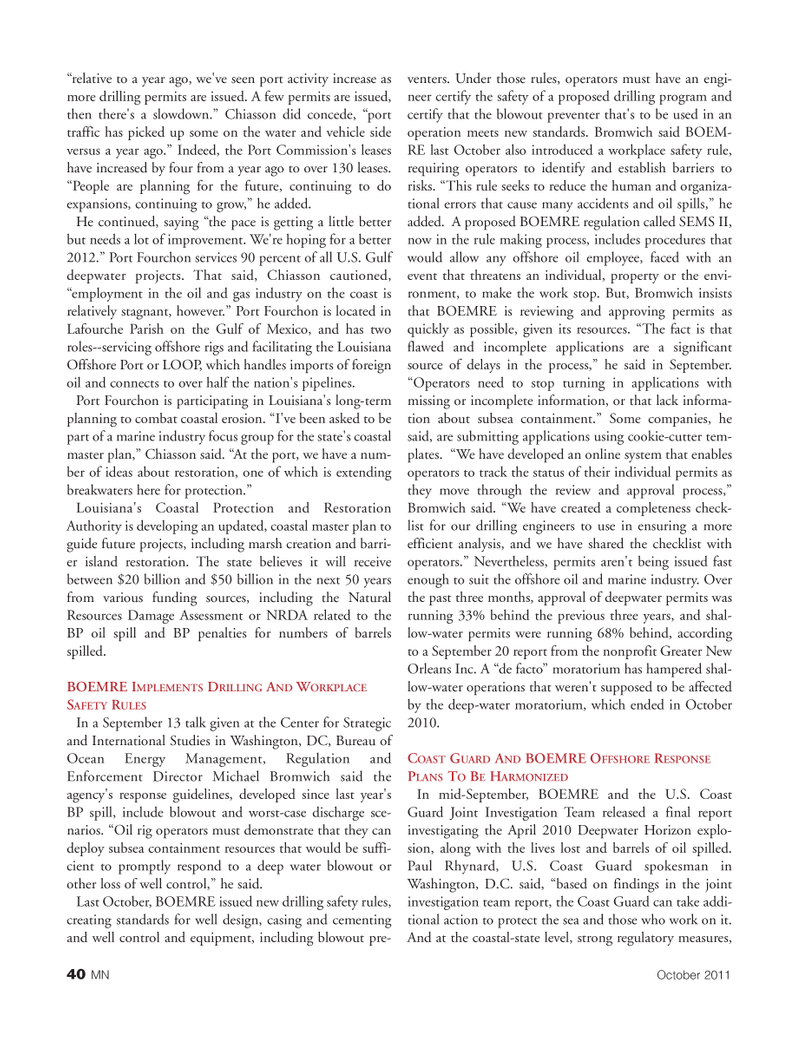
Page 40: of Marine News Magazine (October 2011)
The Yearbook
Read this page in Pdf, Flash or Html5 edition of October 2011 Marine News Magazine
40MNOctober 2011?relative to a year ago, we've seen port activity increase as more drilling permits are issued. A few permits are issued, then there's a slowdown.? Chiasson did concede, ?port traffic has picked up some on the water and vehicle side versus a year ago.? Indeed, the Port Commission's leases have increased by four from a year ago to over 130 leases. ?People are planning for the future, continuing to do expansions, continuing to grow,? he added. He continued, saying ?the pace is getting a little better but needs a lot of improvement. We're hoping for a better 2012.? Port Fourchon services 90 percent of all U.S. Gulf deepwater projects. That said, Chiasson cautioned, ?employment in the oil and gas industry on the coast is relatively stagnant, however.? Port Fourchon is located in Lafourche Parish on the Gulf of Mexico, and has two roles--servicing offshore rigs and facilitating the Louisiana Offshore Port or LOOP, which handles imports of foreign oil and connects to over half the nation's pipelines. Port Fourchon is participating in Louisiana's long-term planning to combat coastal erosion. ?I've been asked to be part of a marine industry focus group for the state's coastal master plan,? Chiasson said. ?At the port, we have a num- ber of ideas about restoration, one of which is extending breakwaters here for protection.? Louisiana's Coastal Protection and Restoration Authority is developing an updated, coastal master plan to guide future projects, including marsh creation and barri- er island restoration. The state believes it will receive between $20 billion and $50 billion in the next 50 years from various funding sources, including the Natural Resources Damage Assessment or NRDA related to the BP oil spill and BP penalties for numbers of barrels spilled.BOEMRE IMPLEMENTS DRILLINGANDWORKPLACE SAFETY RULESIn a September 13 talk given at the Center for Strategic and International Studies in Washington, DC, Bureau of Ocean Energy Management, Regulation and Enforcement Director Michael Bromwich said the agency's response guidelines, developed since last year's BP spill, include blowout and worst-case discharge sce- narios. ?Oil rig operators must demonstrate that they can deploy subsea containment resources that would be suffi- cient to promptly respond to a deep water blowout or other loss of well control,? he said. Last October, BOEMRE issued new drilling safety rules, creating standards for well design, casing and cementing and well control and equipment, including blowout pre- venters. Under those rules, operators must have an engi- neer certify the safety of a proposed drilling program and certify that the blowout preventer that's to be used in an operation meets new standards. Bromwich said BOEM- RE last October also introduced a workplace safety rule, requiring operators to identify and establish barriers to risks. ?This rule seeks to reduce the human and organiza- tional errors that cause many accidents and oil spills,? he added. A proposed BOEMRE regulation called SEMS II, now in the rule making process, includes procedures that would allow any offshore oil employee, faced with an event that threatens an individual, property or the envi- ronment, to make the work stop. But, Bromwich insists that BOEMRE is reviewing and approving permits as quickly as possible, given its resources. ?The fact is that flawed and incomplete applications are a significant source of delays in the process,? he said in September. ?Operators need to stop turning in applications with missing or incomplete information, or that lack informa-tion about subsea containment.? Some companies, he said, are submitting applications using cookie-cutter tem- plates. ?We have developed an online system that enables operators to track the status of their individual permits asthey move through the review and approval process,? Bromwich said. ?We have created a completeness check- list for our drilling engineers to use in ensuring a more efficient analysis, and we have shared the checklist with operators.? Nevertheless, permits aren't being issued fast enough to suit the offshore oil and marine industry. Over the past three months, approval of deepwater permits was running 33% behind the previous three years, and shal- low-water permits were running 68% behind, according to a September 20 report from the nonprofit Greater New Orleans Inc. A ?de facto? moratorium has hampered shal- low-water operations that weren't supposed to be affected by the deep-water moratorium, which ended in October 2010.COAST GUARD ANDBOEMRE OFFSHORERESPONSEPLANS TOBEHARMONIZEDIn mid-September, BOEMRE and the U.S. Coast Guard Joint Investigation Team released a final report investigating the April 2010 Deepwater Horizon explo- sion, along with the lives lost and barrels of oil spilled. Paul Rhynard, U.S. Coast Guard spokesman in Washington, D.C. said, ?based on findings in the joint investigation team report, the Coast Guard can take addi- tional action to protect the sea and those who work on it. And at the coastal-state level, strong regulatory measures, MN#10 (32-49):MN 2011 Layouts 10/5/2011 10:39 AM Page 40

 39
39

 41
41
